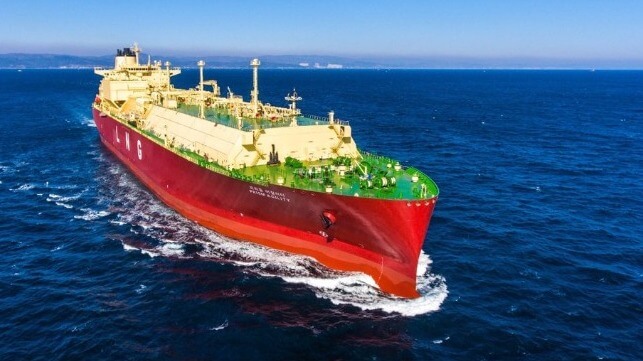KSOE Competes to Design World’s Largest LCO2 Carrier

Expanding on a project launched 13 months ago, Korea Shipbuilding & Offshore Engineering reports that its Hyundai shipyard working with technology partners, a flag state, and a classification society will complete prototype designs for the world’s largest CO2 carrier by the end of this year. The South Korean project is competing against others in South Korea, Japan, Australia, Asia, and Europe that are all working to develop a new sector in shipping specifically to move large volumes of CO2 either for storage or reuse in industrial applications.
Korea Shipbuilding & Offshore Engineering (KSOE) signed a deal that partners Hyundai Heavy Industries, with Hyundai Glovis, and G-Marine Service for the development of the new carrier. The shipyard and technology companies will work with the American Bureau of Shipping (ABS) and Marshall Island Registry's International Registries.
The companies are completing designs for a 74,000-cubic-meter vessel that would be able to transport liquefied carbon dioxide. According to KSOE, it will be the world’s biggest vessel of the kind, betting out a competing design that Daewoo Shipbuilding & Marine Engineering developed also working with ABS. KSOE will expand upon its experience in designing the world's first 40,000 cbm liquefied carbon dioxide carrier. A year ago, KSOE launched a project with Hyundai Mipo and the same partners to develop a ship that could stably maintain and transport liquefied carbon dioxide at low temperature and high pressure.
As part of the new project, in addition to increasing the size of the concept vessel, they will work on an upgrade to the cargo storage system and cargo operation system based on the information and designs developed last year. In addition, the plan calls for the vessel to be equipped with a liquefied natural gas propulsion engine that will be developed to maximize the loading capacity by applying a total of nine cylindrical tanks and to respond to environmental regulations.
KSOE and HHI will design the vessel and are planning on building the prototype after receiving design approvals. Logistics service provider Hyundai Glovis and G-Marine Service will manage the shipping of liquefied carbon dioxide, while ABS and the Marshall Island Registry's International Registries will test the safety of the vessel. They will provide consulting services to verify the stability and suitability of the design based on the international agreement on liquefied gas carriers required by the International Maritime Organization.
Several leading companies in the maritime industry have announced similar plans focusing on large capacity carriers saying that they believed it would provide transportation of large amounts of CO2 over long distances at low costs. Japan’s Mitsubishi Shipbuilding and France’s energy giant TotalEnergies announced that they would work together to explore the opportunities for large tonnage liquid CO2 carriers saying that shipping can provide an economical solution, especially for countries that do not have the infrastructure for carbon capture and storage or industries to use the captured carbon.
Daewoo Shipbuilding & Marine Engineering received design approval in April 2022 for what it then said would be the largest liquified CO2 carrier yet developed. ABS reviewed and approved the design which provides for a capacity of 70,000 cubic meters of LCO2. DSME said the large design was instrumental in creating an economic case for transport and would overcome the challenges of smaller capacity CO2 carriers currently used by the food industry.
The Global CCS Research Institute projects the carbon capture and storage market will grow by more than 30 percent annually. By 2050, they project that the global carbon capture capacity will increase to 7.6 billion tons, and the demand for carbon dioxide carriers is also expected to surge.
